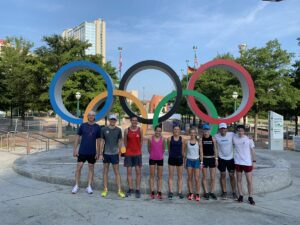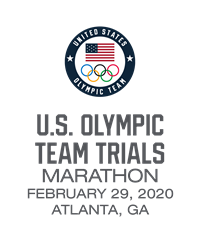LetsRun.com Previews The 2020 US Olympic Marathon Trials Course — Where Cross Country Meets The Marathon
By Steve Soprano
July 11, 2019
*Update: Course Adjustments Announced For The 2020 US Olympic Marathon Trials Rather than the planned 6-mile loop (which the athletes were essentially running four times), there will now be an 8-mile loop which they will run three times. This change “will decrease the number of turns and reduce the overall elevation gain on the course.” Apparently the changes were made in part because the field (mostly the women’s) is much larger than expected.
Last week I was invited to come to Atlanta by the Atlanta Track Club to cover the 50th edition of the Peachtree Road Race. While there, I also had the opportunity to run a section of the course that will be used for the 2020 US Olympic Marathon Trials, which will be held on February 29. The summer heat might make the winter feel like a long way off, but the Olympic dream is a four-year plan and America’s top marathoners will have been looking ahead to February for quite some time. With that in mind, my message to all the Olympic Trials qualifiers out there is, “I hope y’all like hills with your 26.2.”
1,300 Feet Of Elevation Gain
To call the course “hilly” doesn’t really do it justice. I would say during my preview I was running on flat terrain the significant minority of the time and it was pretty much the definition of “rolling hills.” Mostly gradual up and gradual down, but some steeper inclines thrown in there as well, with 1,300 feet of elevation gain in total (there is a 7-foot net elevation gain to the finish since it’s a looped course). To paraphrase what Dathan Ritzenhein reportedly said when he saw the course earlier in the year, it’s basically cross country meets the marathon.
That sounds about right to me because as a guy who always much preferred XC to track, I loved the course. I tried to picture myself racing there and I think a lot of sections will just be fun to compete on for the athletes and entertaining to watch for the fans. With the constant ups and downs, this isn’t going to be an evenly paced time trial. Athletes are going to be able to employ tactics and will likely approach the course differently from each other. The hills will make it interesting, but the course is fair as well. You aren’t running up any mountains and I don’t know if any hills will get infamous names. On the other hand, there are some that definitely aren’t going to feel good when you’re in the last few miles of a marathon.
Four Loops
 Fans of the Walking Dead TV show will recognize this famous shot from the first season. The course passes by here four times.
Fans of the Walking Dead TV show will recognize this famous shot from the first season. The course passes by here four times.
Even though I only ran a little over 8 miles, the looped nature of the course allowed me to pretty much see the whole 26.2. This will obviously be nice for spectators in Atlanta and should make it easy for the runners to get familiar with the course.
As shown on the map embedded at the bottom of this page, the course consists of three 6-mile loops with a final loop of 8.2 miles (which is essentially an extended version of the 6-mile loop). What I ran last week was that final 8.2-mile loop (plus the short distance from the start line to the beginning of the 6-mile loop). The race starts in front of the College Football Hall of Fame and will bring runners by a number of popular landmarks, including the Georgia State Capitol, Georgia State Stadium (which hosted the 1996 Atlanta Games), and Mercedes-Benz Stadium (home of the Atlanta Falcons), before finishing in the center of Centennial Olympic Park.
Eyes In The Back Of Your Head
 The Olympic rings will offer some inspiration ahead of the challenging final two miles
The Olympic rings will offer some inspiration ahead of the challenging final two miles
As I said, the course is hilly, but that isn’t the only feature that will factor in on race day in February. Something I noticed is that there are multiple sections of the course where you double back going the opposite direction from where you came. This will allow runners who are ahead to easily see exactly how much time they have on their competitors and the athletes chasing will know how much they need to make up. By my count, runners will get this “sneak peek” eight times in total, with the final time actually occurring right when you run underneath the 1996 Olympic rings outside Georgia State Stadium, which marks approximately two miles to go.
I can only imagine the thoughts that will go through the minds of the third- and fourth-place runners when they see each other, assuming they’re still close at this point in the race. Only feet apart on opposite sides of the road with a huge symbol hanging over their heads to remind them what they’re fighting for. When I spoke to some of the American pros who were also doing the course preview, they thought this was an interesting feature. 2:29:25 woman Lindsay Flanagan said, “The rings two miles out were cool, even though it was a funny turn.” London 6th placer Emily Sisson (2:23:08 pb) agreed and added that the rings were “a bit of a tease” since you still have two hilly miles to go after you see them.
 Group shot near the finish line in Centennial Olympic Park (Photo courtesy of the Atlanta Track Club)
Group shot near the finish line in Centennial Olympic Park (Photo courtesy of the Atlanta Track Club)
One last thing to note is that in addition to the extensive number of hills, there are also a fair number of turns. Running at an easy pace, I didn’t really feel they were too bad, but they’re obviously going to be a bigger factor when you’re at marathon race pace. If the rolling hills weren’t enough, the turns really hit home that this course is not going to be a smooth ride. In my post-run interview with NAZ Elite coach Ben Rosario (full interview embedded below), he had a warning for all the “rhythm runners” out there: “If you’re someone who likes to get in a nice rhythm, you’re going to have to get out of that mindset because you can keep your effort the same over the entire route, but your pace is definitely going to change…it’s not a rhythm course and you have to be ready for that.”
What Did The Pros Think?
As I mentioned above, I was joined on the run by a group of pros who had raced Peachtree the day before, as well as Rosario and the Atlanta Track Club members who were kind enough to be our tour guides. As the pros are the people who will have to run the race in February (or train athletes to do it, in the case of Rosario), I was very curious to hear what they thought of the course.
2016 Trials 6th placer Kellyn Taylor (2:24:29 pb) of NAZ Elite said, “It’s not as bad as people said, that’s my first impression. But you definitely need to respect it since there are some hills, especially later in the race.” Sisson agreed and added, “I think the 6-mile loop we do three times isn’t actually too terrible…but I think the last three miles is going to be the challenging part…So I think you need to have something left going into the end.” So they both agreed that the final part of the course, which includes the steeper hills, is going to be the biggest hurdle. Flanagan went a step further and said, “The race is probably going to be decided in that last two miles where that last significant hill was. I think that’s going to be a make-or-break point.”
I asked what the highlight or their favorite part of the course was and all three agreed that it was the finish. As you can see from the panoramic shot below, it’s a pretty cool scene, especially, I imagine, when it comes at the end of the Olympic Marathon Trials.
 This view at the finish will look even sweeter if it comes along with an Olympic berth
This view at the finish will look even sweeter if it comes along with an Olympic berth
Rosario shared some interesting coaching insights on the course. He feels it’s a lot like a Boston in the sense that you need to cater your training specifically for this course. He said, “I don’t see how you could be ready for this if you just did what you normally do. You have to tweak something to be properly ready for this.” Specifically, Rosario said that the NAZ Elite runners will probably run a lot of the same training loops they used while preparing for the hills in the Boston and NYC marathons. He thought they might even double down on those types of hilly loops and cut out the faster loops that they usually do.
I asked Rosario what advice he’d give to an Olympic Trials qualifier who wasn’t going to be able to fly out to Atlanta to check out the course.
“You should prepare as if you’re preparing for a race that is 30 miles long because it’s going to take a greater amount of strength than an easier course would take…Certainly, you should be running your faster stuff on up-and-down terrain and you should definitely be doing your fast stuff on pavement. If you’re a person who likes soft surface that’s great, but you should be doing your hardest workouts on pavement because this course in particular because of the ups and downs is going to beat you up even more.”
Course Map:
Video from my course preview run:
***WARNING: If you suffer from motion sickness or care about high production values, do not watch this video.
*Brief staff discussion in the first 12 minutes of the LRC weekly podcast
Note: The Atlanta Track Club paid for Steve Soprano’s expenses to go to Atlanta, but they had no say in his coverage.

